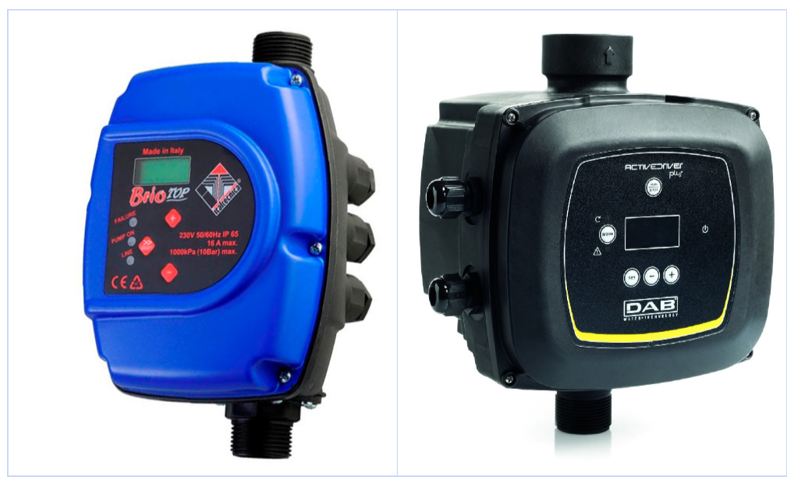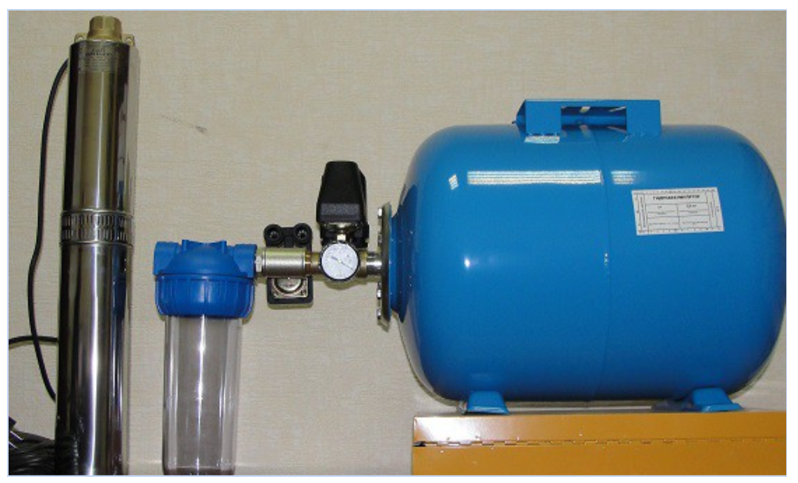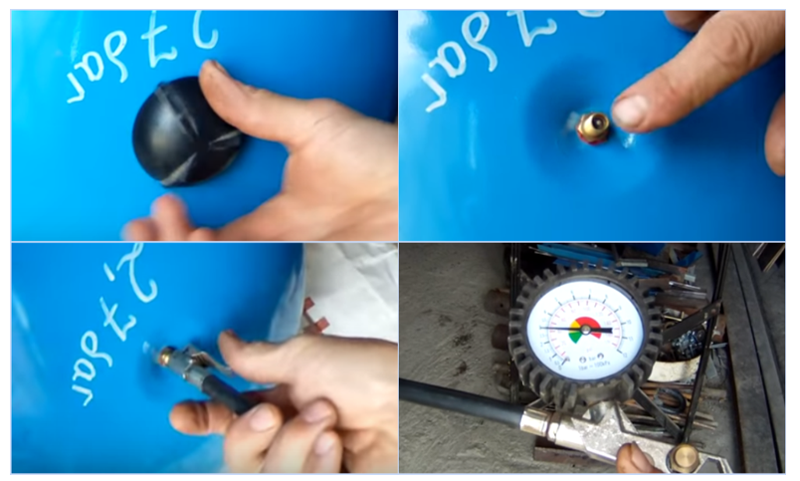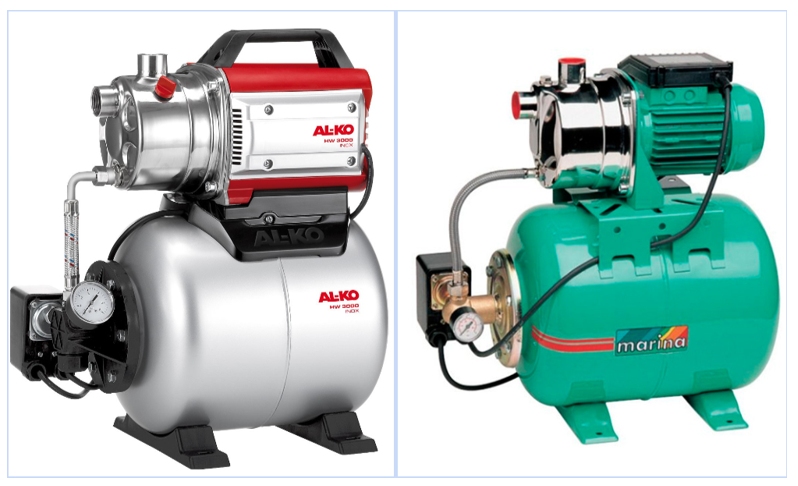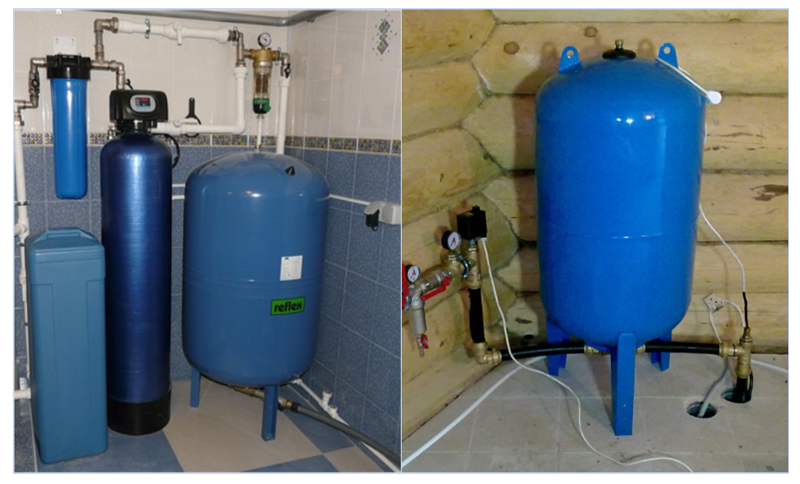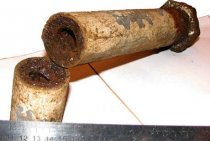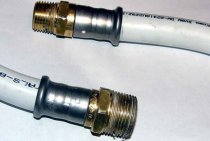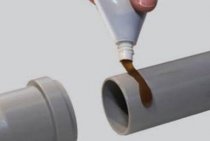Installation of several hydraulic tanks
Some users are faced with the problem of how to connect an additional tank for the water supply line if there is an increase in consumption or the volume of the storage tank is too small for normal operation. The installation of two hydraulic accumulators is not particularly difficult, they can be assembled by connecting in parallel, using an additional adapter fitting, flexible hose or cutting a water pipe.
The advantage of the two-tank system is its high reliability in case the rubber membrane ruptures in one of them.
Rice. 8 Hydraulic tank in the pump frequency control unit
The principle of operation of the hydraulic tank
Typically, the inner bulb is placed in a container with air at a standard pressure of 1.5 bar. When turned on, water is supplied by an electric pump installed in the well into the tank, filling the rubber bulb - it increases in volume, compressing the air space inside. Upon reaching the pressure (standard 3 bar), equal to the threshold of the automatic relay, the electric pump turns off, and the flow of water into the line stops.
When turned on, water flows to the consumer under pressure, which creates a rubber membrane compressed by air. Upon reaching the minimum mark of 1.7 bar. the relay closes the power supply circuit of the electric pump and the line is filled.
Fig. 3 An example of installing a hydraulic accumulator in a water supply system with a submersible pump
Setting the accumulator when connected
Before using a water supply system with a hydraulic accumulator in a private house, you need to know what the pressure in the accumulator should be for its optimal operation; a portable pressure gauge is taken to take readings. A typical water line with a standard pressure switch has response thresholds from 1.4 to 2.8 bar., The factory setting of the pressure in the hydraulic tank is 1.5 bar. In order for the operation of the accumulator to be efficient and to be completely filled, for a given factory setting, the lower threshold for turning on the electric pump is selected by 0.2 bar. more - a threshold of 1.7 bar is set on the relay.
If in the hydraulic tank during operation or due to a long storage period, when measuring with a pressure gauge, it is determined that the pressure is insufficient, proceed as follows:
- Disconnect the electric pump from the power supply.
- Remove the protective cover and press the valve of the hydraulic tank in the form of a nipple head at the outlet of the device - if liquid flows from there, then the rubber membrane has been damaged and must be changed. If air enters from the hydraulic tank, its pressure is measured using a car pressure gauge.
- Drain the water from the line by opening the valve closest to the expansion tank.
- Using a hand pump or compressor, air is pumped into the storage tank until the pressure gauge reads 1.5 bar. If, after automation, water rises to a certain height (high-rise buildings), the total pressure and the operating range of the system are increased based on the fact that 1 bar. equate to 10 meters of vertical water column.
When calculating the required pressure in the hydraulic tank for any range, its value is chosen to be 10% less than the lower threshold of the relay. Selecting this value ensures that the built-in diaphragm expands and contracts within a small range and thus increases the life of the diaphragm and the entire expansion vessel.
Fig.5 Hydraulic accumulator setting
Scheme of connecting the accumulator to the pump and the water supply system
Do-it-yourself installation of a hydraulic accumulator for individual water supply systems is carried out together with automation and adapters, which include a five-input switching fitting, a pressure gauge for adjustment and control, and a switching hydraulic relay. When a downhole electric pump is used in the water intake, the piping for the well includes a dry-running relay and a check valve, if it is not in the pump unit.
If a surface centrifugal electric pump is used in the water main, then it is more practical and cheaper to purchase a ready-mounted pumping station than to install the system elements on your own.
Rice. 4 Expansion tank in the station
How to choose a hydraulic accumulator
When choosing a hydraulic accumulator, it is better to give preference to models with a rubber pear - in membrane types, the liquid contacts the metal case, which can cause corrosion.
The main working element of a balloon hydraulic tank is a pear-shaped membrane, the quality of which determines its service life, while the body material plays a less important role, since it does not come into contact with water
The usual material for making a pear is isobutyl food rubber, when choosing a model for outdoor installation, special attention should be paid to the flange to which the rubber membrane is attached. Preference should be given to models whose flange is made of thick stainless steel or galvanized steel - such a product will last 10-15 years without losing its tightness
Another advantage of a balloon tank is the ease of replacing the rubber membrane. To do this, unscrew several hex bolts securing the flange and remove it together with the shell.
Rice. 9 Vertical hydraulic tanks in the water line
